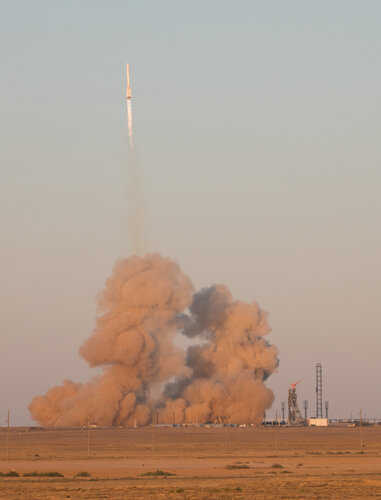It has been an emotional time – years of delays, a tense countdown, a mighty launch and then hiccups in orbit for Russia’s science module ‘Nauka’ together with its travelling companion, the European Robotic Arm (ERA).
The duo is destined to upgrade the International Space Station with a new research facility and a walking robot upon their arrival tomorrow, 29 July. ‘Nauka’, also known as the Multipurpose Laboratory Module (MLM), is the largest space lab ever launched into space by Russia.
Philippe Schoonejans, project manager of the robotic arm for ESA, took this picture a few kilometres away from the launch pad while the Proton-M rocket soared into the sky from the Baikonur Cosmodrome, in Kazakhstan, on 21 July. He was not alone – a dozen colleagues from ESA and the European space industry witnessed the historic launch.
“What an incredible power and what a rattling noise. First, I saw it go and only later the sound came and I felt my shirt move! It was a very emotional moment to see the ERA going into space,” he recalls.
Philippe sighed with relief after waiting 14 years for a liftoff that kept being pushed back. Both Nauka and ERA have had a history of delays and programmatic challenges along the way. And yet again, adversity insisted in being part of the journey to the International Space Station.
As expected, Nauka deployed its solar panels and antennas about 13 minutes after launch, and the eight-day journey to the Space Station began.
However, soon after missing telemetry was reported at the mission control centre in Moscow, Russia. The glitch was detected when the spacecraft did not complete its first burn, aimed at raising its orbit.
During the whole week, flight engineers have been busy running critical propulsion tests and carrying out orbital corrections.
As if this were not enough, the uncertainty was intensified by the troubleshooting of the Kurs rendezvous system on Nauka. Like other Russian modules and spacecraft, Nauka can rendezvous and dock automatically with the International Space Station using its own engines.
Hectic days at mission control culminated last Sunday with the assurance that the spacecraft could reach the Station relying on its own power and navigation systems. Those were four days of suspense for the ERA team too.
The Pirs docking compartment left the Space Station after 20 years of service and burned up safely in the atmosphere above the Pacific Ocean on Monday. Its departure has made room for the new module.
Nauka is now on track to intercept the International Space Station tomorrow, 29 July. Docking to the Zvezda module is scheduled at 15:25 CEST (14:25 BST).
The 13-m long research facility has plenty of room for material science and biotechnology, and features an extra sleeping pod and a new bathroom for cosmonauts. The module can generate oxygen for up to six people and can recycle urine into drinkable water.
The European Robotic Arm travels as a passenger attached to the spacecraft, bringing new potential to the Russian parts of the Space Station. Nauka will be the home base for the first robot that can move back and forwards around the Russian parts, helping install new elements and transporting astronauts during spacewalks.
More on the smart spacewalker in our online brochure, available in English, Dutch and Russian.

 Image:
Space suspense
Image:
Space suspense